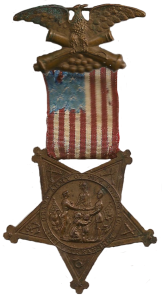Grand Army of the Republic (GAR) – 1 – Background
 In this series of blog posts, you will learn where to look for Grand Army of the Republic records.
In this series of blog posts, you will learn where to look for Grand Army of the Republic records.
The Grand Army of the Republic was a fraternal organization founded in Founded in Decatur, Illinois on April 6, 1866 by Benjamin F. Stephenson. It was open to Union veterans of the Civil War. The veterans served in the U.S. Army, U.S. Navy, Marines and the U.S. Revenue Cutter Service (became the Coast Guard). There were hundreds of posts across the U.S., numbered in sequential order of as they were admitted. The GAR grew powerful politically. From 1866 to 1949. There were over 7000 posts with more than 400,000 members by 1890. There was a “National Encampment” annually; many states also had encampments each year. You may see a GAR insignia on a Union veteran’s tombstone, or a nearby marker.
Five U.S. presidents were GAR members: Ulysses S. Grant, Rutherford B. Hayes, James Garfield, Benjamin Harrison and William McKinley.
Its last member died in 1956, its mission was taken over by the Sons of Union Veterans of the Civil War (SUVCW). The SUVCW was founded in 1881, and is dedicated to the preservation of the history and legacy of these veterans.
There are fourteen categories of records that a post might have. The materials may provide information about the members’ war service and postwar activities. The Post Descriptive books contain information about the members, including birthplace, residence, occupation, service information, discharge information, wounds and other remarks. There were also ledger books, cash books, letters books and minutes books. A brief description of the GAR records can be found at What is A GAR Record?
Your Civil War Union ancestors may have been members of the GAR. Unless you find indexed records, you will need to know the ancestor’s: 1) Name, and 2) Post Number. Knowing the regiment and company will also be helpful to make sure you have located the correct veteran. There are different ways to find the post number. Consider looking for a post located in your ancestor’s town; check the Mortuary tables for the membership; or check an obituary. Once you find the post number, you have to find where the records reside.
Read on to the next posts to learn how to look for these records.



